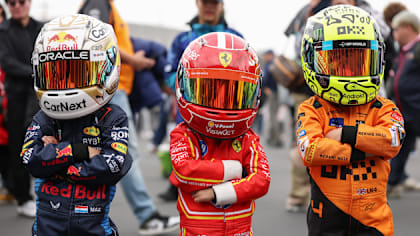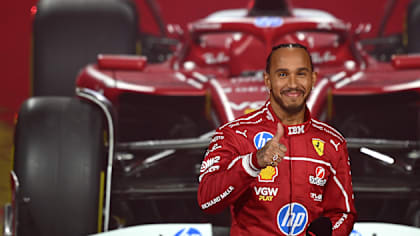In our series exploring the history of Grands Prix through selected iconic images, we turn our attention to one of the most popular races on the calendar: Japan.
This look back through the archives takes in events at both Fuji and Suzuka and includes both of Senna and Prost’s infamous clashes, epic drives by Hill and Raikkonen, a rookie error by Vettel, and more...
Hunt lands title as Lauda pulls out, Fuji, 1976
The 1976 at Fuji was more than just the first world championship Grand Prix to be held in Japan, it was the final race in what was a dramatic and tumultuous season - and more importantly the world championship was still on the line. The two men in contention for the title were McLaren’s James Hunt and his fierce rival, Ferrari’s Niki Lauda. The Austrian, who less than three months earlier had sustained life-threatening injuries in a horror crash in Germany, held a slender three-point lead in the standings heading into the race, but it was the Briton that would ultimately triumph. In appalling weather conditions Hunt finished a dogged third whilst Lauda - his nerves understandably still frayed - was, as this picture shows, one of several drivers to pull out of the race. “It’s just like murder out there,” the Ferrari driver said. “I’m not going to do it. Sometimes I could not tell which direction the car was going. For me it was the limit. For me there is something more important than the world championship.”
(© LAT Photographic)
Senna stalls ahead of epic comeback drive, Suzuka, 1988
Ayrton Senna arrived at the 1988 Japanese Grand Prix, the penultimate race of the season, knowing that victory would secure him his maiden world title. The Brazilian maestro (pictured left) duly grabbed pole, but at the start of the race he stalled his McLaren and was left frantically waving his arms in the air as team mate and title rival Alain Prost (right) took off into the lead. Fortunately for Senna, Suzuka’s grid was situated on a downhill, and as the field swarmed past him on either side, he was able to skilfully bump-start his Honda-powered machine into life. Then the charge began. By lap 14 he’d made his way up to third from 14th and following a brief rain shower than enabled him to showcase his innate ability in tricky conditions he was right on Prost’s tail. On lap 28 the Frenchman could keep his irrepressible team mate behind no longer and Senna swept majestically into the lead along the pit straight. Victory was his, as was the championship. "Until today I always said my best drive was at Estoril in 1985," said Senna afterwards. "But not any more: this was my best."
(© Sutton Images)
Senna and Prost come to blows (part 1), Suzuka, 1989
There was a sense of déjà vu to the 1989 race at Suzuka as once again the McLaren duo of Senna and Prost arrived locked in a battle for the drivers’ title. The Brazilian took pole position, but the Frenchman - who held the edge in the championship - took off into the lead. So, just like the previous year, Senna would have to pass his great rival and team mate. This time, however, Prost was in no mood to be overtaken. As Senna (nearest to the camera) lunged down the inside approaching the chicane on lap 46, Prost turned into the Brazilian causing the cars to lock wheels and come to a standstill. Prost immediately jumped out of his stricken MP4-5, but Senna implored the marshals for assistance and rejoined the race. After a quick stop for a new front wing the Brazilian roared back, passing Benetton’s Alessandro Nannini for the lead, and seemingly, the race victory. But before he could even make it onto the podium, Senna was disqualified in hugely controversial circumstances for cutting the chicane. Prost was the champion, but it would not be the end of the matter…
(© Sutton Images)
Senna and Prost come to blows (part 2), Suzuka, 1990
Somewhat unbelievably, for the third year in succession Senna and Prost arrived at Suzuka in 1990 locked in a battle for the world title. By this point they were in different teams (Prost had left McLaren for Ferrari), but their rivalry was no less acrimonious. Keeping to the script, the two drivers qualified on the front row of the grid, but unlike the year before the fireworks began almost as soon as the start lights went out. Senna, still seething at the injustice of seeing his pole position slot moved from the clean to the dirty side of the grid, was predictably beaten into the first corner by Prost’s scarlet car - but the Frenchman wouldn’t hold the lead for long… “I promised myself that if after the start I lost first place, I would go for it at the first corner, regardless of the result,” Senna would later say. The consequences of the Brazilian’s uncompromising line of thinking are pictured here: contact and both men eliminated on the spot. Senna was champion, but in circumstances no less controversial than the year before.
(© Sutton Images)
Schumacher congratulates Hill after memorable battle, Suzuka, 1994
There weren’t many times in his glittering career that Michael Schumacher was bested in wet weather conditions, but the 1994 Japanese Grand Prix was one of them. In an unusual two-part race that was decided on aggregate times after a rainstorm of biblical proportions forced an early red flag stoppage, the German was pitted in a head-to-head battle with title rival Damon Hill. Schumacher, the championship leader, held the early advantage, but opted for a two-stop strategy rather than the Briton’s one-stopper, so when the Benetton driver made his final stop, Hill accelerated into the lead. Schumacher tried to close the gap to the Williams driver in the final stages, but Hill - who had been seven seconds down on the German at the red flag - would not be beaten, eventually claiming victory by just over three seconds to set up a title showdown at the final race in Australia. Given the circumstances, it was a hugely impressive performance by the Briton, and no one recognised that more than Schumacher (pictured right) who made an immediate beeline to the Williams in parc ferme to shake Hill’s hand.
(© LAT Photographic)
Hakkinen clinches first world title, Suzuka, 1998
In 1998, for the seventh time in 12 years, the world champion was crowned at Suzuka. This time it was McLaren’s Mika Hakkinen (pictured here performing a celebratory lock-up across the finishing line) who triumphed after seeing off the challenge of arch rival Michael Schumacher. It could, however, have been so different had Schumacher - who qualified on pole - not stalled at the start. That relegated the Ferrari driver to the back of the field, relieved the pressure on Hakkinen, and left the Finn with a relatively trouble-free route to victory. For his part, Schumacher - aiming for Ferrari’s first world drivers’ title since 1979 - tried his best to get back into the race, but he was eventually undone by a dramatic right rear tyre puncture while running around 25 seconds back from Hakkinen in third.
(© LAT Photographic)
Schumacher delivers Ferrari’s first drivers’ crown in 21 years, Suzuka, 2000
Having missed his chance to become Ferrari’s first world champion since Jody Scheckter in 1979 when he was defeated by Mika Hakkinen at Suzuka in 1998, Michael Schumacher was determined not to let history repeat itself in 2000. The German left nothing on the table during qualifying, pipping title rival Hakkinen to pole by the miniscule margin of 0.009s, and things were just as close in the race. Hakkinen got the jump at the start and led the early running, but when it started raining towards the end, Schumacher closed in on the Finn. When Hakkinen made his second and final stop, the Ferrari man dropped the hammer, and by the time he made his own stop three laps later, he had enough in hand to emerge ahead of the McLaren driver. From that point on Schumacher (left) held the lead, eventually crossing the line some 1.8s ahead of Hakkinen, sparking jubilant scenes on the podium with Ferrari team principal Jean Todt (right). For Ferrari, 21 years of hurt were over.
(© Sutton Images)
Raikkonen hunts down Fisichella en route to epic victory, Suzuka, 2005
One-lap qualifying wasn’t to everyone’s taste, but it did help to set-up one of the greatest Grands Prix of recent times. In 2005 McLaren’s Kimi Raikkonen was one of the pre-race favourites at Suzuka, but a rain shower midway through Saturday’s one-at-a-time session meant the Finn - who was one of the last to take to the track - ended up a lowly 17th on the grid. Undeterred, Raikkonen took off like a rocket at the start of Sunday’s race, leaping to 12th by the end of a thrilling first lap. The McLaren star continued to climb the order as the race progressed and after making his final stop eight laps from the finish, Raikkonen was just 5.4s down on the Renault of race leader Giancarlo Fisichella. Surely he couldn’t catch the Italian, could he? Yes he could. As the duo swept onto the final lap, Raikkonen (who we’re riding onboard with) tucked in behind Fisichella’s blue and yellow car (right of picture). The Italian defended the inside line into the ultra-fast Turn 1, only for the Finn to sweep boldly around the outside and into the lead. A little over a minute later, Raikkonen completed a famous victory.
(© Formula One World Championship)
Clumsy Vettel costs Webber a shot at victory, Fuji, 2007
There were times in his F1 career when you just had to feel for Mark Webber. The Australian, who retired at the end of last season, finished his career with nine wins, but were it not for incidents like the one pictured here it could easily have been more. This incident occurred during the latter stages of the 2007 Japanese Grand Prix at Fuji which was run in typically torrential conditions. Despite a sickness bug that had caused him to vomit into his helmet in the early part of the race, Webber had worked his way up to second and was closing on race leader Lewis Hamilton when the safety car was deployed for the second time on lap 43. It was at this point, with victory seemingly within reach, that trouble struck the man nicknamed ‘Aussie Grit’. As the field circulated slowly behind the safety car, the pace suddenly slackened. Being careful not to pass Hamilton and incur a penalty, Webber eased off the throttle only to be smashed into from behind by the Toro Rosso of rookie stable mate Sebastian Vettel. For the young German, who had been running an impressive third, there were rueful tears; for Webber only fury at an opportunity missed. The Australian never did win in Japan. His future team mate Vettel on the other hand went on to win four of the next six races in the country…
(© LAT Photographic)
Kobayashi delights home fans with hard-earned podium, Suzuka, 2012
Japanese drivers had starred on home soil before but neither Aguri Suzuki (who took advantage of several high profile retirements in the 1990 race to score his country’s first podium) nor Takuma Sato (who scored a gritty sixth in 2003) saw off such stellar competition as Kobayashi in 2012. The combative Sauber driver caused a stir in qualifying by seeing off the likes of Fernando Alonso, Lewis Hamilton and Kimi Raikkonen to record the fourth quickest time (which became third on the grid when McLaren’s Jenson Button took a gearbox penalty). He then ran as high as second in the race, before eventually claiming third after brilliantly eking enough life out of his struggling rear tyres to hold off the charging Button. “I’ve always felt that if you ever want to look back and regard yourself as a Formula One driver, you have to have been on the podium at least once,” said Kobayashi after claiming Japan’s first home podium in 22 years. “Without such a photo it’s a bit as if you had never been there. So it means a lot to me.”
(© Sutton Images)




